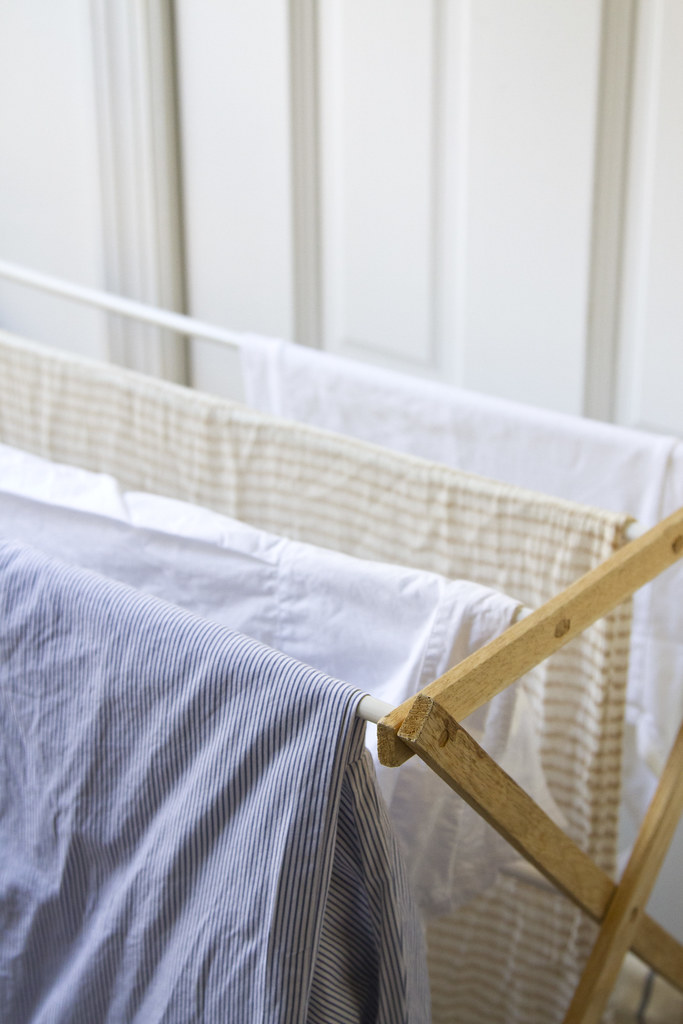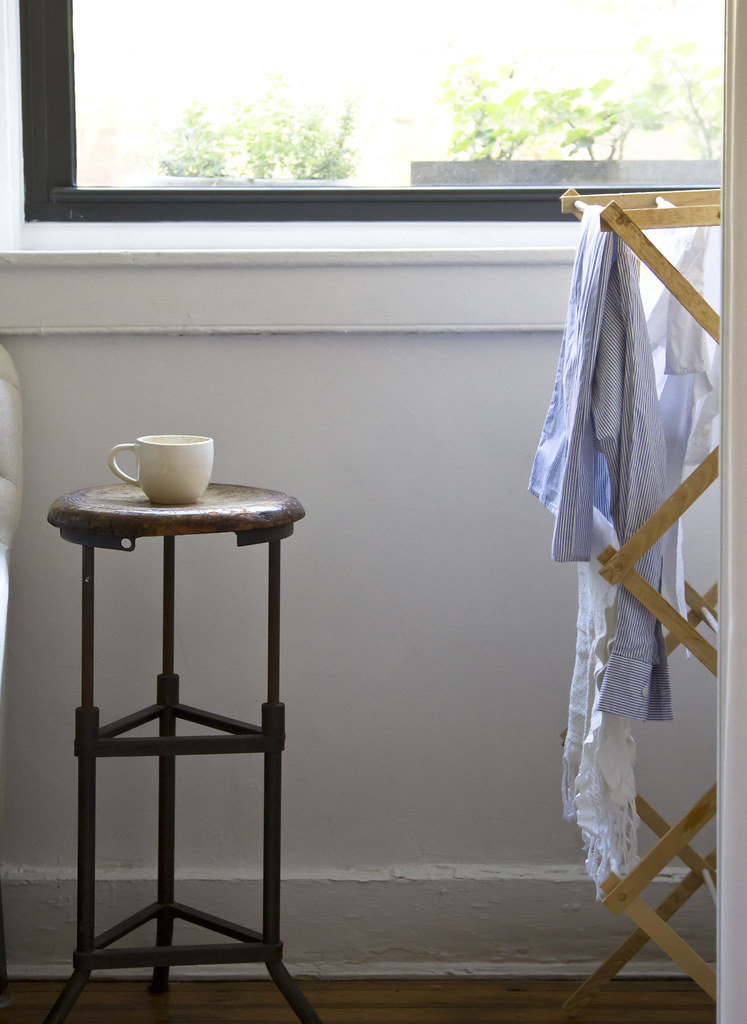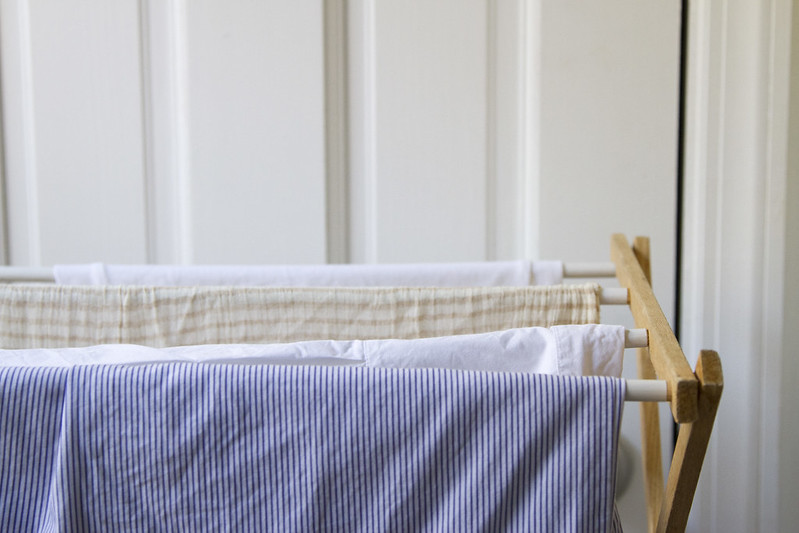Step Four: Care For Your Clothes
You’ve painstakingly grown your minimalist wardrobe using steps ONE, TWO, and THREE. Now you need to take care of the clothes in your limited collection. No pressure.
Before I begin, let me start by saying that I realize there’s danger of sounding like a domestic science whack job when writing about laundry. Here’s a reminder that these are just clothes that we’re talking about. Occupying too much brain space with concerns of laundry isn’t advisable. Clothes wear out. They will get torn and ripped and arm pits will yellow. I don’t think there’s a wool sweater wearer on the planet who hasn’t once accidentally washed a sweater in hot water and rendered it doll’s clothes. You can’t control all wear and tear, you can only try to stave it off. These are a few practical things I do to try to ensure that my clothes stick around for awhile. You will have bits to add, no doubt. Please do.
I’ve mentioned before that one of the great offerings of the New York City service economy is the drop and fold laundry. Without a washing machine or dryer in our building, we’ve decided that sending our laundry off to be cleaned makes sense for our family. But whether you send your clothes out to be cleaned, or have a washer and dryer to call your own, here are a few things that you can do to extend the shelf life of your clothes.
1. Wash in cold water. We wash everything in cold water, no exceptions. For the most part, none of our clothes get truly soiled, so there’s not really a need to use hot water. Cold water means less shrinkage, less fading, and less risk of setting stains. Also: it saves energy. Happily, this is the default mode of the laundromat where we bring our clothes.
2. Separate, separate, separate. We generally do two loads each week: a “lights and whites” and a dark. We separate our laundry into two piles before loading it into our laundry bag and ask the staff at the laundromat to keep them separate when washing. They charge us an extra dollar for the service and it’s a dollar a week that we don’t miss. (Note: The folks at the laundromat who wash our clothes combine the light and dark loads into just one dryer load. Save one unfortunate incident with a very linty sweater, we’ve never had an issue with taking this approach. The takeaway: Wash separately, dry together.)
3. Pre-treat. We use a stain removing bar soap on anything that looks like it might need some extra love—lately that means soiled diaper covers, soon enough it will mean strawberry dribble. (We keep our unwrapped soap in a lidded glass jar in the bathroom, just in case you wanted to know how the heck to store it.)


4. Use a gentle detergent. In keeping with the notion that most of our clothes are not truly very deeply soiled, we’ve always found that a gentle, lightly scented detergent is more than enough to get our clothes clean. We’ve been using this detergent lately. It’s free of dyes and just about every other creepy toxin and scented with 100% essential oils. We keep a bottle of our own detergent at the laundromat where our clothes get washed and a small bottle at home to tackle any hand washing projects.
lately. It’s free of dyes and just about every other creepy toxin and scented with 100% essential oils. We keep a bottle of our own detergent at the laundromat where our clothes get washed and a small bottle at home to tackle any hand washing projects.
5. Wash by hand. I try to choose clothes that require hand washing fairly carefully. This is mostly because I’m lazy. A wool sweater that requires hand washing, for instance, is something that I might only wash a time or two a season (especially if I always wear a cotton t-shirt underneath). A shirt that’s tight fitting and gets sweaty after one wear is something I’d probably choose not to buy because it would require much more regular care. When I do have hand-wash-only duds to wash, I save them up until there are a few that need cleaning and then do them all at once. Disclosure: I most often end end up handwashing when I realize we haven’t made it to the laundromat and I need to wear something or other that’s dirty.
6. Hang dry. We hang dry many of our clothes—whether suggested by the manufacturer or no. When we separate our laundry by color, we also include a bag of what we fondly refer to as “no dries.” We typically pick up our clothes on the same day that we drop them off and bring our wet clothes back home to finish drying on our own drying rack . When clothes specify that they be laid flat to dry, I put an old towel over the top of our rack and call that flat enough. Washing a wool sweater and rolling it dry in a towel to rid it of some extra moisture goes a long way to reducing dry time without doing the dreaded “wring dry.”
. When clothes specify that they be laid flat to dry, I put an old towel over the top of our rack and call that flat enough. Washing a wool sweater and rolling it dry in a towel to rid it of some extra moisture goes a long way to reducing dry time without doing the dreaded “wring dry.”
Note: If you live in a place where space is at a premium, a clothes rack can make things feel crowded, fast. Solidarity, sisters. The best way to combat that is timing and placement. Wash in the afternoon so that clothes can dry overnight and stick the rack by the window or in the middle of the room where air is circulating. As soon as they’re dry, fold ’em up and the rack. too. If you have high ceilings, let yourself indulge in the fantasy of a Sheila Maid. If you have outdoor space, consider hanging a laundry line .
.


7. Use a lingerie bag. I spent most of my life thinking that lingerie bags were for fancy people only. Now I realize they’re for smart people. Hand washing is an excellent idea, but when that’s not possible, corralling all of your delicates into a zipped bag will help prevent them from getting snagged or run ragged by the spin cycle.
8. Store carefully. Most everyone I know has a moth story. Mine is the beret my grandfather wore in France in the 40s, now polka-dotted with tiny holes. Natural fibers have natural predators; do what you can to fend them off with moth sachets (to make, or buy) and zipped up bags and boxes. And then develop a thick skin about ruined woollies. Alas, alack.
and zipped up bags and boxes. And then develop a thick skin about ruined woollies. Alas, alack.
More about growing a minimalist wardrobe, HERE.





14 Comments
This is some great advice! I really should get on the lingerie bag as Ive noticed my bras really get wrangled.
I wish I could get a Sheila Maid, that would be perfect for our apartment.'
Do you hang most of your clothes or fold them up? We dont have much room for hanging so a lot of our stuff ends up a little wrinkled from folding. Any tips on that?
Thanks,
http://www.southernfolly.com
Hi Erin – Thanks for addressing this, it's definitely a preoccupation of mine (perhaps I am a domestic science whack job). The only other thing I would recommend is this amazing soap http://www.eucalan.com/
It's great for hand-washing woolens and delicates because it doesn't need to be rinsed out, really simplifying the process. I love their lavender scent.
Thank you for the tips, Erin! I never thought of washing everything in cold water, but it really makes sense! I tend to hang dry all our clothes and use the dryer only for bed sheets and towels, cause the dryer we use (the one in our building) tends to shrink some clothes. I had several dresses getting too short after the first wash. I love your drying rack by the way!
I use a thing called washing soda as a detergent, it’s pure sodium-carbonate (Na2 CO3) , a phosphate free, easily bio-degradable powder, it’s absolutely cheap, especially as I buy it in bulk in a paper bag (half a kilo is enough for us for a whole year, and it costs the price of a loaf of quality bread).
It’s important that the powder must be dissolved in boiling water first and the liquid form is to be used, because the powder is non soluble in just (luke)warm or cold water at all. But once dissolved, it stays so for some time, so I usually make a liter of it (5 teaspoons of powder into a liter of boiling water), and keep using that as a liquid detergent. I need an espresso coffee cup of it for one washing (for a normal size washing machine, battling “city life” dirt only). It's not to be stored in an aluminum bottle, only in glass / plastic though.
+ (and this is optional, and many people using washing soda don’t do this, but ) I pour a tiny amount of “poison+additive”-free liquid soap right into the bin of the machine too, onto the top of the clothes (this will be upgraded into me buying the cheap, simple real soap bar and melt a piece of it in hot water).
+ And into the rinse water tube: I add a bit of water and just put 5 drops of lemon oil essence onto it: (for smell and antibacterial qualities).
—————
I used to do the cold water wash too, but read that cold water leaves most bacteria just live on happily on the clothes (and my dr. Biologist sweetheart confirmed this info as probably true, though he is no expert of this specific field). So I switched to warm water usage (a very subjective decision of course, given the fact that even if washing is no rocket science, neither of us have any expert idea of what’s really right or wrong in bacteria world on our clothes…).
PS. I love this series too!
sorry, the right measure is: 5 normal spoonful, not teaspoon…
I have such a difficult time hand-washing things that require it. I'll do it once, and then start to get lazy about it, tossing it into the laundry hamper and avoiding the "separating" step all together.
Terrible habit that I'm trying to break. As we get older, we buy better quality items, and I know my old habits need to be kicked to the wayside before I ruin a $150 shirt!
More great advice, Erin, thanks for sharing!
http://throughthereels.blogspot.com
I'd add: zip up zippers before washing. Open zippers can be really abrasive on clothes in a washing machine, plus zipping them up can help your clothes keep their shape if the washing machine you use has a vigorous spin cycle.
Moths + cashmere= anger
(I'm shaking my fist toward my closet right now…). I still haven't parted with the moth-eaten cashmere sweater. It is too painful.
You know I loved this so much! I'm with you on that beautiful sheila maid fantasy. Great post!
Yesssssss for hang drying! We have a laundry line outside (our rental abode is tiny, but our yard is large and came with a line=jackpot) and in the winter we use a wood drying rack like the one you pictured. I was just telling a coworker today how lint is literally clothes breaking down.
One thing we do is roll up our clothes to store them, like we're traveling all the time :). I thought it would be a pain at first, but it really doesn't take any longer than a regular fold. It saves us a little space and helps prevents some wrinkles.
Also, I know many have said it, but I so enjoyed this series! Bravo!
Sheila Maid! That's awesome.
Do you have a recommendation on a type of drying rack? I've been wanting to get one but don't really know where to start! I usually hang dry all my clothes on hangers hanging from the bathroom rod.
I'm a bit late to the laundry party, eeh. But I recently learned that underwear/towels/linens should be washed warm, over 60 degrees celsius – because of bacteria not dying in cool water. Like you I've used warm water sparingly and never had much trouble, so I'm not sure I should believe this bacteria propaganda.. Maybe your biologist husband has some input? 🙂
Hi Erin,
I am really trying to take better care of the clothes I love. I’m also really keen on really engaging with the process of cleaning my home in a more mindful and considered way. I was wondering if you recommended a good book that I could download for my holiday that covers these topics? I feel like i need to learn the basics. On my last holiday to France I read your book and it was the perfect treat, thank you so much,
Jo
Comments are moderated.